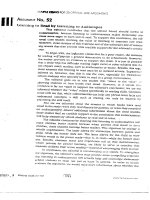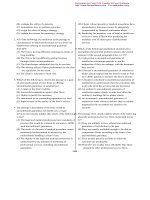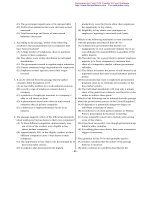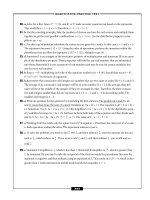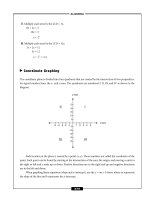GMAT exam success Episode 2 Part 4 pdf
Bạn đang xem bản rút gọn của tài liệu. Xem và tải ngay bản đầy đủ của tài liệu tại đây (136.23 KB, 20 trang )
Each of these underlined adjectives has much more impact than the adjective good. These exact mod-
ifiers create a vivid picture; they tell the reader more precisely what is good about the argument and how it
is effective.
Use exact verbs, nouns, adjectives, and adverbs throughout your essay. The more precise you can be, the
more impact your writing will have.
APPROPRIATE
LEVEL OF FORMALITY
Your audience determines your level of formality, and this is also controlled by word choice. The level of for-
mality can range from the very informal (slang) to the very formal (esoteric and ceremonial) to everything
in between. Writers use word choice and sentence structure to manipulate the level of formality. Here are two
examples:
A: It was so cool. I mean, I never saw anything like it before. What a great flick! You have to check it out.
B: It was really an impressive film, unlike anything I’ve ever seen before. You should definitely go see it.
These two sentences are drastically different in style and, in particular, in the level of formality. Although
they both tell the same story and use the personal first-person I, each writer has a different relationship with
the reader. The word choice and style
—
the short sentences and the very casual language
—
indicate that the
writer of passage A has a more informal, more friendly relationship with the reader than the writer of pas-
sage B. The emotion of the writer in passage A is much more transparent, too, because the language is more
informal and natural. You get the idea that passage A is addressed to a close friend, whereas passage B might
be addressed to a colleague or supervisor.
In your essay, be sure to write at an appropriate level of formality. Do not use slang, but do not be exces-
sively formal either. For example, the following sentence is too informal and slangy for the general audience
of the GMAT exam:
The restaurant owners would be nuts to just get up and move. They have other things that they should
check out first.
Be more formal without overstepping the bounds into pretentious or ceremonial language as this writer
does:
The restaurant owners would be unwise to move without first considering other alternatives to improving
their business.
CONSISTENT AND APPROPRIATE TONE
A consistent and appropriate tone is another essential element of effective writing. To n e is the mood or atti-
tude conveyed by words or speech. Think, for example, of all the different ways to say “sure” or “hello.” How
you say the word conveys so much of its meaning.
– GUIDE TO EFFECTIVE WRITING–
249
When we speak, we create tone by how quickly or slowly we say a word, how loudly or softly we say it,
and how we use facial expressions and body language. When we write, though, our readers can’t hear how our
words sound, and they certainly can’t see our facial expressions or body language. However, we can use word
choice to convey our tone. For example, if you are describing a humorous event, you might use the phrase
topsy-turvy rather than chaotic or disorganized. Similarly, if you are describing an unpleasant event, you might
use the word tumultuous or helter-skelter to convey the same idea.
Punctuation is also an important tool in creating tone. For example, look carefully at this pair of sen-
tences:
Wait, I’m coming with you.
Wait
—
I’m coming with you!
Although the words in the sentences are exactly the same, the tone is quite different. In this example,
it’s not word choice but punctuation that changes the tone. The first sentence is calm and neutral. The sec-
ond sentence, on the other hand, is emotional and excited. The first sentence, with its comma and period, does
not express emotion. The second sentence clearly expresses more urgency and excitement, thanks to the dash
and exclamation point.
People use an endless variety of tones when they speak. Likewise, people use an endless variety of tones
when they write, from cheerful to somber, uplifting to bleak, sincere to sarcastic, and everything in between.
On the GMAT exam, however, you will have little room to play with tone. Given the kinds of essays you have
to write on the AWA, and given the elements your readers will be looking for as they score your writing, your
best bet is to stick to a serious, respectful tone throughout your essay.
Sentence Variety and Techniques for Emphasis
A strong GMAT essay also demonstrates an ability to manipulate sentence structure and punctuation for
effect. Sentence structure, as noted earlier, is an important element of style. If all of your sentences have the
same pattern, you will end up with monotonous and dry writing, such as the following passage:
Corporations have a moral responsibility to contribute to society. They should support education,
nonprofit services, or the arts. They will empower their leaders and employees to serve their com-
munity by doing so. They will also reap rewards in the short and long term. They will improve
morale and grow their bottom line.
Unsophisticated and quite dull, isn’t it? This is because all of the sentences are short and share the same
structure; they all start with corporations/they ϩ helping verb ϩ present tense verb. This is quite different from
parallel structure, which is the repetition of sentence pattern to create rhythm within a sentence or para-
graph. (See page 118 for a review of parallel structure.) This kind of repetition only creates monotony and
shows a lack of flexibility in creating sentence patterns. Here’s the same paragraph, but it has been revised to
show variety in sentence structure:
– GUIDE TO EFFECTIVE WRITING–
250
Corporations have a moral responsibility to contribute to society by supporting education, nonprofit
services, or the arts. By doing so, they empower their leaders and employees to serve their commu-
nity, and they will reap rewards in the short and long term, including increased morale and a
stronger bottom line.
Notice how much more interesting this paragraph is now. The five sentences have been combined into
two, and only one sentence starts with the subject. Many of the short sentences have been turned into clauses
and phrases, creating varied sentence patterns.
Sentence structure and punctuation can also be used to create emphasis and enhance meaning. Often,
the best place to put sentence elements that you want to emphasize is at the end (the “save the best for last”
approach). What comes last is what lingers the longest in the readers’ mind.
He is tall, dark, and handsome. (The emphasis is on handsome. If tall was the most important charac-
teristic, then that should come last.)
She is smart, reliable, and experienced. (The emphasis is on experienced;ifsmart is the most important
characteristic, then that should be last in the list.)
This also works with the not only/but also construction. In this sentence, the word order puts the empha-
sis on the corporation’s obligation to employees and stockholders:
Successful corporations have an obligation to the general public as well as to their employees and stock-
holders.
By revising the sentence so that public is the last element, the emphasis is properly shifted on the obli-
gation to society:
Successful corporations have an obligation not only to their employees and stockholders but also to the
general public.
You can also use a dash to set off part of a sentence for emphasis:
Successful corporations are not only obligated to their employees and stockholders
—
they are also obli-
gated to the general public.
In the previous example, the stress on the last element is heightened by the dash, which emphasizes the
importance of this obligation to society.
– GUIDE TO EFFECTIVE WRITING–
251
Do Not Repeat Yourself
On the sentence level, in general, less is more. The fewer words you use to get your point across, the better.
Redundancy is the unnecessary repetition of ideas. Wordiness is the use of several words when a few can
express the same idea more clearly and concisely. Avoid both of these as you write your essay.
Wordiness and redundancy typically result from three different causes:
• The use of unnecessary words or phrases
Redundant: The owners must think about and consider the costs and expenses
of moving.
Concise: The owners must consider
the costs
of moving.
Wordy: The restaurant may need improvement in the areas of food or service.
Concise: The restaurant may need to improve its food or service.
• The use of wordy phrases instead of adjectives or adverbs
Wordy: A survey would show in a clear way
whether the restaurant needs to improve its food or service.
Concise: A survey would clearly show
whether the restaurant needs to improve its food or service.
• The use of the passive instead of active voice
Passive: Moving to improve business was an idea consider
ed by the owners of the restaurant.
Active: The owners of the restaurant considered the idea of moving to improve business.
Do not skimp on details, but do not waste words either.
For a more detailed review of ways to eliminate redundancy and reduce wordiness, see pages 129–131.
252
Writing Correctly: The Conventions of Standard Written English
One of the main elements upon which your essay will be judged is its adhesion to the conventions of stan-
dard written English. This means that your sentences should be grammatically correct, use proper idioms and
sentence structure, and be free of errors in mechanics
—
punctuation, spelling, and capitalization. The essen-
tials of grammar and usage were covered in the Verbal section review on pages 109
—
136. This section will list
the grammar rules you need to remember and review the guidelines for punctuation, capitalization, and
spelling.
Rules for Grammar and Usage
1. The basic word order for sentences is subject-predicate: subject, verb, indirect object, and object.
2. Make sure sentences have both a subject and a predicate and express a complete thought.
3. Respect sentence boundaries. Don’t let two or more independent clauses run together.
4. Keep modifiers as close as possible to the words they modify.
5. Use parallel structure for any series of actions or items or the not only/but also construction.
6. Make sure verbs agree in number with their subjects.
7. Keep verb tenses consistent.
8. Use the correct subject or object form of personal pronouns. Determine whether a pronoun is func-
tioning as a subject or object in the sentence.
9. Use apostrophes with pronouns to show contraction only. Pronouns do not need apostrophes to show
possession.
10. Use who for people, that for things, and which for nonessential clauses that do not refer to people.
11. Pronouns must agree in number and person with their antecedents.
12. Be consistent in pronoun point of view.
13. Use less for singular nouns representing quantity or degree. Use fewer for plural nouns.
14. Use good and bad to describe nouns and pronouns; use well and badly to describe verbs.
15. In comparisons, add -er or -est for short modifiers. For longer words, use more/most or less/least before
the modifier.
16. Do not use double comparisons or double negatives.
17. Use idioms correctly.
Punctuation
Punctuation marks are the symbols used to separate sentences, express emotions, and show relationships
between objects and ideas. Correct punctuation clarifies meaning and adds drama and style to sentences. Poor
punctuation, on the other hand, can confuse your readers and distort your intended meaning. For example,
take a look at the following two versions of the same sentence:
Don’t bother Xavier.
Don’t bother, Xavier.
The same words are used, but the two sentences have very different meanings because of punctuation.
In the first sentence, the comma indicates that the speaker is telling us not to bother Xavier. In the second sen-
tence, the speaker is telling Xavier not to bother. Here is another example of how punctuation can drastically
affect meaning:
You should eat Zak so you can think clearly during your interview.
Because this sentence is missing some essential punctuation, the sentence says something very differ-
ent from what the author intended. The speaker isn’t telling us to eat Zak; rather, she is telling Zak to eat. The
sentence should be revised as follows:
You should eat, Zak, so you can think clearly during your interview.
As you saw earlier, punctuation also has another important function: It enables writers to express a vari-
ety of tones and emotions.
– GUIDE TO EFFECTIVE WRITING–
253
PUNCTUATION
GUIDELINES
There are many rules for punctuation, and the better you know them, the more correctly and effectively you
can punctuate your sentences. This table lists the main punctuation marks and guidelines for when to
use them:
IF YOUR
PURPOSE USE THIS
IS TO PUNCTUATION EXAMPLE
End a sentence. period [.] Most sentences end in a period.
question mark [?] I feel tired today.
exclamation point [!] However, if you are posing a question, use a
question mark.
Should the voting age be raised to 21?
Exclamation points should be used sparingly
for emphasis.
"What a beautiful dress!"
Connect complete semicolon [;] A semicolon can connect two sentences; it is
sentences (two comma [,] and a an excellent way to show that two ideas are
independent conjunction [and, or, nor, related.
clauses). for, so, but, yet] Leslie is coming, but Huang is staying home.
dash [ — ] (less common,
Hurry up—we’re late!
but more dramatic)
Connect items in a list. comma [,] but if one or His odd shopping list included batteries, a box
more items in that list of envelopes, and a can of beans.
already has a comma,
The castaways included a professor, who was
use a semicolon [;]
the group’s leader; an actress; and a
millionaire and his wife.
Introduce a list of colon [:] There are three things I want to do before I
three or more items. die: go on a cruise, go skydiving, and surf.
Introduce an explanation colon [:] You know what they say about real estate:
(what follows explains or
Location is everything.
answers what precedes).
Introduce a quotation colon [:] or comma [,] She yelled, “Let’s get out of here!” He said
(words directly spoken). only one word: “Believe.”
Indicate a quotation. quotation marks [“ ”] “To be or not to be?” is one of the most
famous lines from Hamlet.
Indicate a question. question mark [?] What time is it? “How much longer?” he
asked.
– GUIDE TO EFFECTIVE WRITING–
254
IF YOUR
PURPOSE USE THIS
IS TO PUNCTUATION EXAMPLE
Connect two words that hyphen [-] mother-in-law, turn-of-the-century poet,
work together as one French-fried potatoes
object or modifier.
Separate a word or dash [—] I never lie—never. We’re late—very late!
phrase for emphasis.
Separate a word or commas [,] Elaine, my roommate, is from Chicago. Her
phrase that is relevant nickname as a child, her mother told me, was
but not essential “Boo-boo.”
information.
Separate a word or parenthesis [()] There is an exception to every rule (including
phrase that is relevant this one).
but secondary information.
Show possession or apostrophe [‘] Why is Lisa’s wallet in Ben’s backpack?
contraction.
C
OMMA RULES
Although you won’t drop from a score of 6 to 5 because of a couple of misplaced commas, the correct use of
commas is important. The presence and placement of commas can dramatically affect a sentence’s meaning
and can make the difference between clarity and confusion in your sentences. The previous chart lists four
different uses of commas, but there are several others. Here is a complete list of comma rules. The better you
know them, the more clear, correct, and controlled your sentences will be.
Use a comma in the following ways:
1. With a coordinating conjunction to separate two complete sentences. Note that a comma is not
required if both parts of the sentence are four words or less:
Let’s eat first, and then we will go to a movie.
I’m definitely older, but I don’t think I’m much wiser.
I love him and he loves me.
2. To set off introductory words, phrases, or clauses.
Next 4th of July, I plan to watch the fireworks from the rooftop.
Wow, that sure looks good!
Because the game was cancelled, Jane took the kids bowling.
– GUIDE TO EFFECTIVE WRITING–
255
3. To set off a direct address, interjection, or transitional phrase.
Well, Jeb, it looks like we will be stuck here for a while.
His hair color is a little, um, unusual.
My heavens, this is spicy chili!
Sea horses, for example, are unusual in that the males carry the eggs.
4. Between two modifiers that could be replaced by and.
He is a quiet, shy person.
(Both quiet and shy modify person.)
Incorrect: Denny’s old, stamp collection is priceless.
Correct: Denny’s old stamp collection is priceless.
(You cannot put and between old and stamp; old describes stamp and stamp modifies collection.
They do not modify the same noun.)
5. To set off information that is relevant but not essential (nonrestrictive).
Essential, not set off:
The woman who wrote Happy Moon is coming to our local bookstore.
(We need this information to know which woman we’re talking about.)
Nonessential, set off by commas:
The dog, lost and confused, wandered into the street.
(The fact that the dog was lost and confused is not essential to the sentence.)
Essential, not set off:
Witnesses who lie under oath will be prosecuted.
Nonessential, set off by commas:
Leland, who at first refused to testify, later admitted to lying under oath.
6. To separate items in a series.
The price for the cruise includes breakfast, lunch, dinner, and entertainment.
The recipe calls for fresh cilantro, chopped onions, diced tomatoes, and lemon juice.
– GUIDE TO EFFECTIVE WRITING–
256
7. To set off most quotations. As a general rule, short quotations are introduced by commas, whereas
long quotations (several sentences or more) are introduced by colons. All speech in dialogue should be
set off by commas.
“Let’s get going,” he said excitedly.
Emmanuel Kant is famous for the words, “I think, therefore I am.”
Joseph said, “Please forgive me for jumping to conclusions.”
8. To set off parts of dates, numbers, titles, and addresses.
She was born on April 30, 2002.
Please print 3,000 copies.
Tiberio Mendola, M.D., is my new doctor.
Please deliver the package to me at 30 Willow Road, Trenton, NJ.
9. To prevent confusion, as in cases when a word is repeated.
What it is, is a big mistake.
After I, comes J.
Capitalization
Capitalization is an important tool to help us identify (1) the beginning of a new sentence and (2) proper
nouns and adjectives. Here are six rules for correct capitalization:
1. Capitalize the first word of a sentence.
Please close the door.
What are you trying to say?
If you are quoting a full sentence within your own sentence, use a capital letter, unless you intro-
duce the quote with that.
According to the study, “A shocking three out of four students admitted to cheating.”
The study claims that “a shocking three out of four students admitted to cheating.”
If you have a full sentence within parentheses, that sentence should be capitalized as well (and the
end punctuation mark should be within the parentheses).
ABC Corporation regularly contributes to the We Care Fund (including an impressive donation of
$10,000 in 2002).
ABC Corporation regularly contributes to the We Care Fund. (They donated an impressive $10,000
in 2002.)
– GUIDE TO EFFECTIVE WRITING–
257
2. Capitalize proper nouns. A proper noun is the name of a specific person, place, or thing (as opposed to
a general person, place, or thing).
CAPITALIZE (SPECIFIC) DON’T CAPITALIZE (GENERAL)
Jennifer Johnson (specific person) the woman
Business Law (specific class) my law class
Main Street (specific street) on the street
Frosted Flakes
®
(specific brand) good cereal
Caspian Sea (specific sea) deep sea/ocean
Lincoln Memorial (specific monument) impressive memorial/monument
U.S.S. Cole (specific ship) naval carrier
Dade Management School (specific school) my graduate school
Precambrian Age (specific time period) long ago
Data Corporation (specific company) that company
Exceptions: Do not capitalize words such as river, street, and so on in plural proper nouns as they
are generic: the Pacific and Indian oceans.
3. Capitalize the days of the weeks and months of the year, but not the seasons.
It was a warm spring day in May.
Wednesday is the first official day of autumn.
4. Capitalize the names of countries, nationalities, languages, religions, and geographical locations (but
not geographical directions).
He has traveled to Brazil and Tunisia.
She is half Chinese, half French.
She is from the South. Drive south for five miles.
We speak Spanish at home.
He is a devout Catholic.
– GUIDE TO EFFECTIVE WRITING–
258
5. Capitalize titles that come before proper names.
Judge Lydia Ng Lydia Ng, judge in the Fifth District
Professor Lee Chang Lee Chang, professor of physical science
Vice President Tilda Stanton Tilda Stanton, vice president
6. Capitalize titles of publications, including books, stories, poems, plays, articles, speeches, essays, and
other documents, as well as works of art, including films, paintings, and musical compositions.
Pablo Picasso’s painting Guernica captures the agony of the Spanish Civil War.
Read Susan Sontag’s essay “On Photography” for class tomorrow.
The Declaration of Independence is a sacred document.
Spelling
Although a few misspellings will probably have little impact on your AWA score, misspelled words can inter-
fere with clarity, and if your reader’s pet peeve is misspelled words, a few spelling errors may have more influ-
ence on your score than they deserve. To that end, review these spelling rules, especially the correct use of
contractions and homonyms. A list of frequently misspelled words is included at the end of this chapter.
B
ASIC SPELLING GUIDELINES
Here are ten guidelines for correct spelling. Please remember that there are exceptions to every rule. If spelling
is one of your weaknesses, spend extra time reviewing these rules and the list of frequently misspelled words
that appears at the end of this chapter.
1. Form plurals of regular nouns by adding -s or -es.
job jobs
house houses
beach beaches
2. Change the spelling of words with the following endings when forming plurals:
f → v
thief thieves
wolf wolves
but not
belief beliefs
chief chiefs
– GUIDE TO EFFECTIVE WRITING–
259
consonant ϩ y → ie
family families
party parties
but not vowel ϩ y:
toy toys
monkey monkeys
sis → ses
basis bases
hypothesis hypotheses
on → a
criterion criteria
phenomenon phenomena
us → i
nucleus nuclei
radius radii
3. Double consonants when adding -ing, -ed, -er, or -est when:
• the verb stem contains one vowel ϩ one consonant in one syllable
grab grabbing grabbed
trip tripping tripped
• the verb stem contains two or more syllables with one vowel ϩ consonant in the final stressed
syllable
prefer preferring preferred
control controlling controlled
(but not travel, traveling, traveled because the stress is on the first syllable)
• the suffix -er or -est is added to one-syllable adjectives ending in one vowel ϩ consonant
big bigger biggest
hot hotter hottest
• adding -ly to an adjective ending in l
joyful joyfully
successful successfully
4. Change final y to ie on certain verb forms when verb ends in consonant ϩ y:
cry cries crying cried
study studies studying studied
– GUIDE TO EFFECTIVE WRITING–
260
5. Change final y to i in two-syllable adjectives when adding a suffix:
happy happier happiest
silly sillier silliest
friendly friendlier friendliest
6. In general, i comes before e except after c, unless the syllable sounds like ay:
believe receive sleigh
niece deceive neighbor
Exceptions:
science
species
height
foreign
7. Keep a silent -e when adding an -ly suffix or a suffix beginning with a consonant:
state stately statement
rude rudely rudeness
8. Drop a silent -e before a suffix beginning with a vowel:
admire admirable
approximate approximation
9. Drop -le in adjectives when adding -ly:
admirable admirably
sensible sensibly
10. With adjectives ending in -ic, add -ally to form the adverb:
tragic tragically
comic comically
C
ONTRACTIONS AND POSSESSIVES
Confusion between contractions and possessives results in some of the most common spelling mistakes. Con-
tractions are words that use an apostrophe to show that a letter or letters have been omitted from the
word(s). Possessive pronouns indicate ownership of objects and ideas. They do not take an apostrophe.
– GUIDE TO EFFECTIVE WRITING–
261
POSSESSIVE PRONOUN MEANING EXAMPLE
its belonging to it The dog chased its tail.
your belonging to you Your time is up.
their belonging to them Their words were comforting.
whose belonging to who Whose tickets are these?
CONTRACTION
it’s it is It’s time to eat.
you’re you are You’re not going to believe your eyes.
they’re they are They’re getting their tickets now.
who’s who is/who has Who’s got my tickets?
Whenever you come across a question with a contraction, read it as two words. If it doesn’t make sense,
then you need a possessive pronoun, not a contraction. Eliminate the apostrophe.
HOMONYMS
Homonyms are words that sound alike but have different spellings and meanings. Here are some of the most
common homonyms:
accept to take or receive
except leave out
affect (v.) to have an influence
effect (n.) the result or impact of something
all ready fully prepared
already previously
bare (adj.) uncovered; (v.) to uncover
bear (n.) animal; (v.) to carry or endure
brake (v.) to stop; (n.) device for stopping
break (v.) to fracture or rend; (n.) a pause or temporary stoppage
buy (v.) to purchase
by (prep.) next to or near, through
– GUIDE TO EFFECTIVE WRITING–
262
cite (v.) to quote or mention as an example
sight (n.) something seen or visible; the faculty of seeing
site (n.) location; (v.) to locate
desert (n.) dry area; (v.) to abandon
dessert (n.) sweet course at the end of a meal
every day (adv.) each day
everyday (adj.) ordinary, daily
fair (adj.) light in color; favorable; just, unbiased; (n) gathering or exhibition
for sale of goods, shows, and entertainment
fare (n.) price charged for a passenger to travel; food provided; (v) to
progress (we fared well on our journey)
hear (v.) to perceive with the ears
here (adv.) in this place
know (v.) to understand, be aware of
no (adj./adv.) negative—opposite of yes
loose (adj.) not tight, not confined
lose (v.) to misplace; to fail to win
may be (v.) might be (possibility)
maybe (adv.) perhaps
morning (n.) the first part of the day
mourning (n.) grieving
passed (v.) past tense of pass (to go by)
past (adv.) beyond; (n.) events that have already occurred
patience (n.) quality of being patient, able to wait
patients (n.) people under medical care
personal (adj.) private or pertaining to the individual
personnel (n.) employees
presence (n.) condition of being
presents (n.) gifts
principal (adj.) most important; (n.) head of a school
principle (n.) fundamental truth
– GUIDE TO EFFECTIVE WRITING–
263
right (adj.) correct; (adv.) opposite of left
rite (n.) ceremony
write (v.) produce words on a surface
scene (n.) setting or view
seen (v). past participle of see
than (conj.) used to compare (he is taller than I)
then (adv.) at that time, therefore (first this, then that; if you think it’s good,
then I’ll do it)
their (pn.) possessive form of they
there (adv.) location; in that place
through (prep.) in one side and out the other; by means of
threw (v. past tense of throw
to (prep.) in the direction of
too (adv.) in addition, excessive
two number
waist (n.) part of the body
waste (v.) to squander; (n.) trash
weak (adj.) feeble
week (n.) seven days
weather (n.) climatic conditions
whether (conj.) introducing a choice
which (adj./pn.) what, that
witch (n.) woman with supernatural powers
Unfortunately, the only thing you can do to master homonyms is to memorize the correct meanings and
spellings. Try using mnemonic devices to remember which word is which. For example,
stationary versus stationery: Remember that “stationery” is the one to write on because it is spelled
with an “er” like the letter you are writing.
(See page 25 in Chapter 2 for more about mnemonic devices.)
For a list of over 700 pairs of homonyms, visit www.cooper.com/alan/homonym_list.html. You can also
find homonym quizzes and worksheets at />– GUIDE TO EFFECTIVE WRITING–
264
– GUIDE TO EFFECTIVE WRITING–
265
absence
abundance
accidentally
accommodate
acknowledgment
acquaintance
aggravate
alibi
alleged
ambiguous
analysis
annual
argument
awkward
basically
boundary
bulletin
calendar
canceled
cannot
cemetery
coincidence
collegiate
committee
comparative
completely
condemn
congratulations
conscientious
consistent
convenient
correspondence
deceive
definitely
dependent
depot
descend
desperate
development
dilemma
discrepancy
eighth
eligible
embarrass
equivalent
euphoria
existence
exuberance
feasible
February
fifth
forcibly
forfeit
formerly
fourth
fulfill
grateful
grievance
guarantee
guidance
harass
hindrance
ideally
implement
independence
indispensable
inoculate
insufficient
interference
interrupt
jealousy
jewelry
judgment
leisure
length
lenient
liaison
lieutenant
lightning
loophole
losing
maintenance
maneuver
mathematics
millennium
minuscule
miscellaneous
misspell
negotiable
ninth
occasionally
occurred
omission
opportunity
outrageous
pamphlet
parallel
perceive
permanent
perseverance
personnel
possess
potato
precede
preferred
prejudice
prevalent
privilege
procedure
proceed
prominent
pronunciation
quandary
questionnaire
150 Most Commonly Misspelled Words
receipt
receive
recommend
reference
referred
regardless
relevant
religious
remembrance
reservoir
responsible
restaurant
rhythm
ridiculous
roommate
scary
scissors
secretary
separate
souvenir
specifically
sufficient
supersede
temperament
temperature
truly
twelfth
ubiquitous
unanimous
usually
usurp
vacuum
vengeance
visible
Wednesday
wherever
– GUIDE TO EFFECTIVE WRITING–
266
The following section offers specific tips and strategies to use on the AWA during the exam. Practice these
strategies as you complete the sample essay prompts that follow.
General Writing Strategies
■
Remember the general guideline for dividing your time on an essay exam: use about one-fourth of the
time to plan, one-half of the time to write, and one-fourth of the time to revise and edit.
■
Look for key words in the essay prompt to be sure you address all aspects of the assignment.
■
The key to brainstorming is to avoid censoring yourself. Keep an open mind and write down whatever
ideas come to you. You do not have to use everything in your essay.
■
Remember that your brainstorming and outline are for your eyes only. Use whatever brainstorming
and outlining techniques you find most useful.
■
On an essay exam, every minute counts. Don’t wait around for ideas to come to you. If you are having
trouble coming up with ideas, use brainstorming techniques such as listing and freewriting to get ideas
down on paper.
CHAPTER
Tips and
Strategies
for the AWA
16
267
■
A good thesis makes an assertion about the topic; it does not just repeat the topic or ask a question.
Make sure your thesis takes a clear position on the issue or argument.
■
Your planning time is probably the most crucial part of an essay exam. Create a detailed outline to
organize your ideas. Revise your outline before you begin writing to make sure you have sufficient sup-
port and specific examples and that you have addressed all of the elements in the prompt.
■
Make sure you have at least two or three supporting ideas for your thesis. If no other organizational
pattern makes sense, put them in order of importance, with your most important idea last.
■
Remember, it’s important to get going and keep moving. If you can’t think of the exact word or phrase
you are looking for, approximate. You can come back to fix it later if you have time. For now, writing
something that is close enough must be good enough so you can get the rest of your ideas down.
■
Remember to keep it simple. Your time is limited, and your readers will be looking for basic structural
and organizational elements. Don’t worry about impressing your readers with sophisticated organiza-
tion or style; you don’t need anything out of the ordinary to impress your readers. A formulaic but
clear essay will do better than one that is overly complex.
■
Remember that first impressions are important, but it’s more important to finish your essay. Don’t get
hung up trying to write a perfect introduction. Simply summarize the argument or issue and state your
thesis. If you have time later, you can come back and write a catchier introduction.
■
Signpost, signpost, signpost. Use strong transitions throughout your essay to make the relationships
between ideas clear. Remember that both your human reader and E-rater® will be looking for these
guides.
■
A specific fact or detail has more power than a general statement. Include specific examples whenever
possible.
■
In general, unless you have less than five minutes left, revise first and then edit. Save your grammar and
spelling check until after you have made “big picture” changes to your essay. If you are nearly out of
time, read through your essay quickly and make any revisions or editorial changes.
■
If a sentence seems unclear to you, it may be that you are trying to do too much in one sentence. Try
breaking it up into two simpler sentences that are more clear.
■
Remember the guidelines for effective style: be precise, be concise, use the active voice, vary the sen-
tence structure, and avoid jargon and pretentious language. Make sure you use an appropriate level of
formality and a serious, respectful tone throughout your essay.
■
Correct punctuation is important, but don’t get hung up on trying to determine whether you need a
comma or a semicolon. Make your choice quickly and move on to the next issue.
■
If you are unsure about capitalization, ask yourself whether the word in question is something specific
or general. If it is a specific person, place, or thing, then it probably should be capitalized. Remember, in
this regard, specific means particular or individual, not detailed. For example, a poodle is a specific type
of dog, but it is not capitalized because it doesn’t refer to a specific (individual or particular) dog.
Rover, however, should be capitalized because Rover is a specific (individual or particular) dog.
■
If you have the time, read your essay backward line by line. This will enable you to spot errors that you
might miss reading straight through.
– TIPS AND STRATEGIES FOR THE AWA–
268




